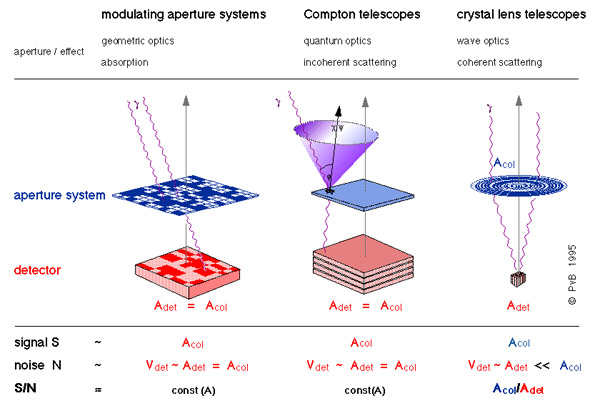
Introductions to high-energy astrophysics traditionally begin by deploring
the extreme experimental difficulties this discipline has to deal with.
Nuclear astrophysics suffers from a handicap that is ultimately caused
by the loss of information during inelastic interaction processes of gamma-ray
photons with matter. Unlike the photons at longer wavelengths that mainly
undergo coherent scattering in the atmosphere and in the telescopes, gamma-rays
interact with matter primarily by incoherent processes. We have become
used to accept that it is “impossible to reflect or
refract gamma-rays” that have wavelengths two to three orders of magnitude
shorter than the distances between atoms in solids.
Consequently, present types of telescopes for nuclear astrophysics
make use of inelastic interaction processes : most of the instruments are
based on geometrical optics (shadowcasting in modulating aperture systems)
or quantum optics (kinetics of Compton scattering). Because the collecting
area of such systems is identical to the detector area, nuclear astrophysics
has come to a mass-sensitivity impasse where “bigger is not necessarily
better”. Improving the sensitivity of an instrument can usually be obtained
by a larger collection area - in the case of classical gamma-ray
telescopes this can only be achieved by a larger detector surface.
Yet, since the background noise is roughly proportional to the volume of
a detector, a larger photon collection area is synonymous with higher instrumental
background. The sensitivity is thus increasing at best as the square root
of the detector surface.

While space agencies presently express their wish to launch lighter
payloads in the future, the new results of SIGMA and GRO indicate that
the next generation of instruments should have not only better sensitivities
but also better angular and energy resolution.
A possible way out of this impasse consists in reconsidering to take
advantage of the phase information of the photons. So far, no telescope
relying on elastic coherent scattering has been employed at gamma-ray energies.
However, Rayleigh scattering by tightly bound atomic electrons can be significant
in high-Z material when very small angles of incidence on a crystal lattice
are implied.
Today,the Laue diffraction lens has demonstrated its potential in laboratory measurements even at several hundred keV : Gamma-rays are focused from a large collecting area onto a small detector volume. As a consequence, the background of the crystal diffraction telescope is extremely low, making possible unprecedented sensitivities.
update : january 1999
questions and comments: Peter
von Ballmoos